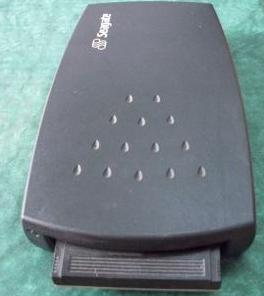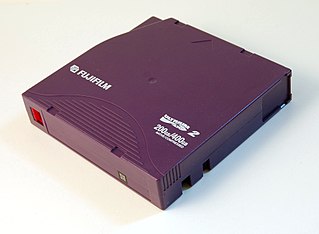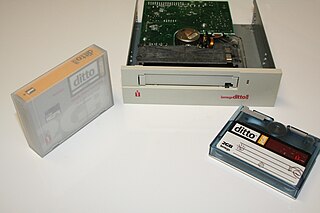

Travan is an 8 mm magnetic tape cartridge design developed by the 3M company, used for the storage of data in computer backups and mass storage. [1] Over time, subsequent versions of Travan cartridges and drives have been developed that provide greater data capacity, while retaining the standard 8 mm width and 750' length. Travan is standardized under the QIC body. HP Colorado, Iomega DittoMax and AIWA Bolt are proprietary versions of the Travan format. [2]

Magnetic tape is a medium for magnetic recording, made of a thin, magnetizable coating on a long, narrow strip of plastic film. It was developed in Germany in 1928, based on magnetic wire recording. Devices that record and play back audio and video using magnetic tape are tape recorders and video tape recorders respectively. A device that stores computer data on magnetic tape is known as a tape drive.
A computer is a machine that can be instructed to carry out sequences of arithmetic or logical operations automatically via computer programming. Modern computers have the ability to follow generalized sets of operations, called programs. These programs enable computers to perform an extremely wide range of tasks. A "complete" computer including the hardware, the operating system, and peripheral equipment required and used for "full" operation can be referred to as a computer system. This term may as well be used for a group of computers that are connected and work together, in particular a computer network or computer cluster.
In information technology, a backup, or data backup is a copy of computer data taken and stored elsewhere so that it may be used to restore the original after a data loss event. The verb form, referring to the process of doing so, is "back up", whereas the noun and adjective form is "backup". Backups can be used to recover data after its loss from data deletion or corruption, or to recover data from an earlier time. Backups provide a simple form of disaster recovery; however not all backup systems are able to reconstitute a computer system or other complex configuration such as a computer cluster, active directory server, or database server.
Contents
The Travan format competes mainly against the DDS, AIT, and VXA formats.

Digital Data Storage (DDS) is a computer data storage technology that is based upon the digital audio tape (DAT) format that was developed during the 1980s. DDS is primarily intended for use as off-line storage, especially for generating backup copies of working data.

Advanced Intelligent Tape (AIT) is a discontinued high-speed, high-capacity magnetic tape data storage format developed and controlled by Sony. It competed mainly against the DLT, LTO, DAT/DDS, and VXA formats. AIT uses a cassette similar to Video8. Super AIT (SAIT) is a higher capacity variant using wider tape in a larger, single-spool cartridge. Both AIT and SAIT use the helical scan method of reading and writing the tape.

VXA is a tape backup format originally created by Ecrix and now owned by Tandberg Data. After the merger between Ecrix and Exabyte, VXA was produced by Exabyte Corporation. On November 20, 2006, Exabyte was purchased by Tandberg Data who has since stopped further development of the format.









